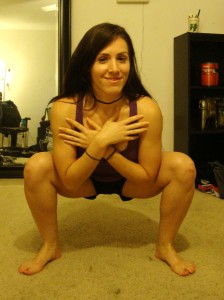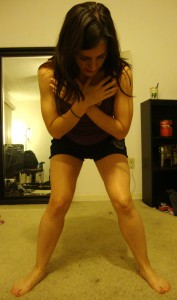Admittedly, I’m a bit competitive.
Whenever I see a girl getting ready to do a barbell squat (a rare occasion), I always watch her from the corner of my eye to see how many plates she puts on the bar. Recently I was taken aback by how heavy two different girls loaded up their bars. Until I saw how low they went. Or rather, how low they DIDN’T go.
Yesterday a 16- or 17-year-old girl was squatting 135 lbs (for 15 reps!), and a few weeks ago I saw a bodybuilder chick squatting 225 lbs. The only thing was, their range of motion was extremely limited. They only did quarter squats, which is where their thighs don’t even go parallel to the floor. It’s a lot easier to squat a heavy-ass weight when you’re only going down a few inches. For the record, I can squat 125 for something like 4 sets of 4 reps. The difference is that I go ASS TO GRASS! That’s when you go all the way down.
In my opinion, squats are the king of exercises. No other exercise is as challenging, or rewarding. Squatting works multiple muscle groups AND your cardiovascular system, boosts your metabolism for hours after you’ve exercised, and gives you a nice butt. But to get the full benefit of squatting, you should try going down as low as possible, or at least get your thighs parallel to the floor.
So why should you go ass to grass? When you do a partial squat, it’s mainly recruiting your quadriceps. When you do a full squat, you are using your glutes and hamstrings in addition to your quads. That makes for a more balanced exercise. By only doing partial squats, you can develop muscle imbalances (which lead to injury), and you are placing anterior stress on your knees that isn’t being balanced by the posterior pull that happens when you do a full squat.
Squatting is a great indicator of lower body mobility, so if a person cannot successfully do a full-range-of-motion squat, it’s most likely because of tightness in the hips, knees, or ankles. Improving your flexibility will help to improve your squat.
Some people argue that squats ruin your knees, but the fact is that unless you have a pre-existing condition, squats can actually strengthen your knees and help to prevent injuries. The thing is that you have to make sure your form is correct. When you start doing things like rounding your back, bending your knees inward, and letting your knees pass your toes on the descent, then you’re setting yourself up for problems.
Here are some tips on how to squat.

If you are doing a traditional squat, stand with feet shoulder-width apart. Point your toes out slightly. You can also stand with your feet pointing straight ahead, but I find that pointing your toes out a little helps to prevent your knees from dipping inward. Your knees should ALWAYS be pointing in the same direction as your toes.
Move your hips back as if you were going to sit back in a chair and bend your knees. Keep your back straight. Think of this movement as horizontal more than vertical. Your are moving your hips back horizontally, and then lowering yourself by bending your knees and dropping your butt down.
Go as low as you can. Keep your back straight and try not to let your butt tuck in. It needs to be sticking out.
DO NOT DO THESE THINGS:

Round your back.
Let your knees bend inward. This usually happens as a slight movement when you are coming back up, rather than being a fixed position during the whole exercise. Like I said, pointing your toes out a little helps a lot with this.
Let your knees pass your toes. If you are doing this, you are moving more vertically than horizontally. People who squat like how I am in the picture above are not sticking their butt back enough. Try practicing by sitting back on a chair. Do that until you can squat without the chair.
Keep in mind that your unique anatomy is going to effect your form. Short people have a much easier time squatting than tall people because well, their legs are shorter. It comes more naturally to them.
The best thing to do is ask a professional to observe your form and correct it if need be. And if you have knee problems or have ever had knee injuries, then you should most certainly consult with a physical therapist before attempting squats. However, if you’ve never had any injuries, practicing body-weight squats at home is a good way to learn. That’s how I did it in the beginning.
More info on full squat flexibility.
Now get off the leg press machine and do some squats!










i love squats! they make me happy and i like to watch twerking videos too!
love life
p.s I do it all the time on the toilet.
Comment..
I like it,love it and need it though i’ve just started body building….hahaha. But hey,will you keep helping me cos i need to know more,thanks